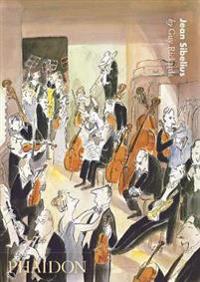Högtärade Maestro! Högtärade Herr Baron! : korrespondensen mellan Axel Carpelan och Jean Sibelius 1900-1919 (Inbunden)
avSibelius, Jean, Carpelan, Axel
ISBN: 9789173533720 - UTGIVEN: 2010-08-30Efter Axel Carpelans död 1919 antecknade Sibelius i sin dagbok För hvem skall jag numera komponera? Brevväxlingen mellan dem inleddes nitton år tidigare och utvecklades till en nära vänskap. Enslingen Carpelan saknade musikutbildning men kunde likväl skänka Sibelius åtskilliga impulser, ett[...]
Symphonies 1 and 2 in Full Score (Häftad)
avJean Sibelius, Music Scores, Jean Sibelius
ISBN: 9780486278865 - UTGIVEN: 199311Symphonies celebrated for mastery of symphonic forms and orchestral scoring, reprinted from the definitive full-score editions published by Breitkopf & Hartel of Leipzig.
[...]Finlandia, Valse Triste and Other Works for Solo Piano (Häftad)
avJean Sibelius, Classical Piano Sheet Music, Jean Sibelius
ISBN: 9780486411620 - UTGIVEN: 201001Unique compilation presents best of Finnish composer's piano music in one convenient, inexpensive volume. Original piano transcriptions by Sibelius of Finlandia and Valse triste, plus Six Impromptus, Sonata in F Major, Kyllikki (Three Lyric Pieces), Three Sonatinas, Two Rondinos, many more. Authorit[...]
Finlandia And Other Tone Poems in Full Score (Pocket)
avJean Sibelius
ISBN: 9780486264837 - UTGIVEN: 1991-02Full orchestral scores of "Finlandia, Valse Triste, The Swan of Tuonela, Lemminkainen's Return, En Saga, Pohjola's Daughter, Night Ride and Sunrise, " and "The Oceanides." Masterly compositions reveal the Finnish composer's great gifts for thematic development and formal structure, as well as his ab[...]
Great Twentieth-Century Violin Concertos in Full Score (Pocket)
avJean Sibelius, Alexander Glazunov, Francis A. (EDT) Davis
ISBN: 9780486285702 - UTGIVEN: 1995-07Authoritative editions of Sibelius' Violin Concerto in D Minor, Op. 47; Elgar's Violin Concerto in B Minor, Op. 61; and Glazunov's Violin Concerto in A Minor, Op. 82.
[...]Symphonies Nos. 3 and 4 in Full Score (Häftad)
avJean Sibelius, Music Scores
ISBN: 9780486426686 - UTGIVEN: 200304"It is hard to think of any music in which the composer is more spontaneous and masterful, and uncompromising in his thought."--Olin Downes, "Thompson's International Cyclopedia.
These revolutionary works brought a strikingly organic--almost architectural--unity to the symphony that music histori[...]Jean Sibelius and His World (Pocket)
avDaniel M. (EDT) Grimley
ISBN: 9780691152813 - UTGIVEN: 2011-08Perhaps no twentieth-century composer has provoked a more varied reaction among the music-loving public than Jean Sibelius (1865-1957). Originally hailed as a new Beethoven by much of the Anglo-Saxon world, he was also widely disparaged by critics more receptive to newer trends in music. At the heig[...]
Jean Sibelius
ISBN: 9780714847764 - UTGIVEN: 2008-04Jean Sibelius (1865-1957) is perhaps Finland's most important cultural figure; his beautiful music, inspired primarily by Finnish landscapes and literature, helped to form a national identity for his homeland. Sibelius's innovative symphonies and descriptive tone poems encapsulate the composer's des[...]
Finlandia: Sheet (Okänt format)
avJean Sibelius, John W. Schaum
ISBN: 9780769291345 - UTGIVEN: 1985-03John W. Schaum has produced a very orchestral and dynamic transcription based on the famous symphonic piece of Jean Sibelius. With four pianists creating the depth and rich textures, rhythms and range of the orchestra, the full effect and glory of the original work are wonderfully reproduced for the[...]
My Music, My Drinking & Me: The Memoirs of Jean Sibelius (häftad)
ISBN: 9780952780441 - UTGIVEN: 2015-10Jean Sibelius (Inbunden)
avTomi Makela
ISBN: 9781843836889 - UTGIVEN: 201110This acclaimed study, available in English for the first time, looks at the music of Jean Sibelius in its biographical context. Myths have surrounded Sibelius (1865-1957) and his work, for more than 100 years, often diverting attention away from his creative output. Drawing on many unpublished sour[...]
Jean Sibelius: Flute Solo (Scaramouche) Op.71 (häftad)
ISBN: 9788759853382 - UTGIVEN: 1992-01(Music Sales America). This work is from Scaramouche, Sibelius' tragic pantomime. The piece is taken from the incidental music of the pantomine, and is arranged here for Flute and Piano.[...]
13 Pieces Op. 76, No.2 - Etude: Piano (Häftad)
avJean Sibelius
ISBN: 9788759854105 - UTGIVEN: 1998-01(Music Sales America). Work for solo piano dating from 1911.
Jean Sibelius. D. 1 : Åren 1865-1893 (Inbunden)
avErik Tawaststjerna
ISBN: 9789174860290 - UTGIVEN: 1993-02-01Detta är den första delen av Tawaststjernas stora verk om Jean Sibelius i fem band.
Boken börjar med en inledning om Sibelius och romantikens inre konflikt. Kapitlen som följer handlar om Sibelius barndom, skol- och studietid. Han flyttar till Helsingfors för att studera vid Musikinstitutet.[...]Jean Sibelius. D. 2 : Åren 1893-1904 (Inbunden)
avErik Tawaststjerna
ISBN: 9789174860542 - UTGIVEN: 1994-03-01Sommaren 1893 beslutar sig Jean Sibelius för att komponera en opera till libretto ur Kalevala. Projektet leder till en djup kompositorisk kris och genomförs inte. Av Sibelius efterlämnade brev framgår hur de nedlagda operaplanerna samtidigt blev en stor uppgörelse med Wagnertraditionen större[...]
Jean Sibelius. D. 4 : Åren 1914-1919 (Inbunden)
avErik Tawaststjerna
ISBN: 9789174863307 - UTGIVEN: 199610Detta är fjärde delen av Erik Tawaststjernas stora verk om Jean Sibelius.
I denna biografiserie tecknar författaren en enastående le¬vande bild av Sibelius utveckling både som människa och som konstnär.
Denna del omfattar tiden 1914 1919. Sommaren 1914 hade Sibelius k[...]Jean Sibelius. D. 5 : Åren 1920-1957 (Inbunden)
avErik Tawaststjerna
ISBN: 9789174864830 - UTGIVEN: 1997-11-01Detta är den femte och avslutande delen av Erik Tawast¬stjernas stora verk om Jean Sibelius. Denna utgåva represen¬terar den »sista versionen« av Tawaststjernas manuskript, eftersom författarens tillägg och bearbetningar under senare år beaktats.
I början av 1920-talet kunde Sibelius va[...]Jean Sibelius (Inbunden)
ISBN: 9789518513646 - UTGIVEN: 2010-01Kansainvälisesti maineikkain säveltäjämestarimme Jean Sibelius (1865-1957) tunnetaan tarkkaan valituista valokuvista, joiden sommittelu, ilme ja tunnelma viestivät usein jylhää suuruutta, keskittyneisyyttä, vakavuutta. Kodissaan, myyttisessä Ainolassa, kuvattuna Sibeliuksella oli myös herk[...]
Dining With Jean Sibelius (Övrigt)
avRisto Lehmusoksa, Ritva Lehmusoksa
ISBN: 9789527043257 - UTGIVEN: 2015-01With special permission from Sibelius's heirs, the authors gained unprecedented access to the private collections of his home, Ainola, and the National Archives of Finland. Vivid new and vintage photographs enliven the dramatic tale of Sibelius's life (1865-1957)."The master is quite a gourmet," sai[...]



























